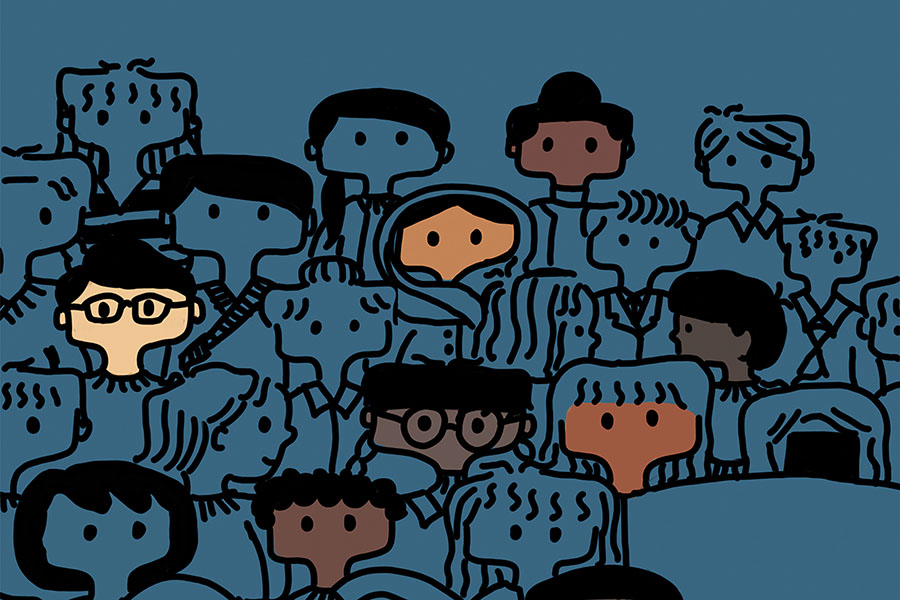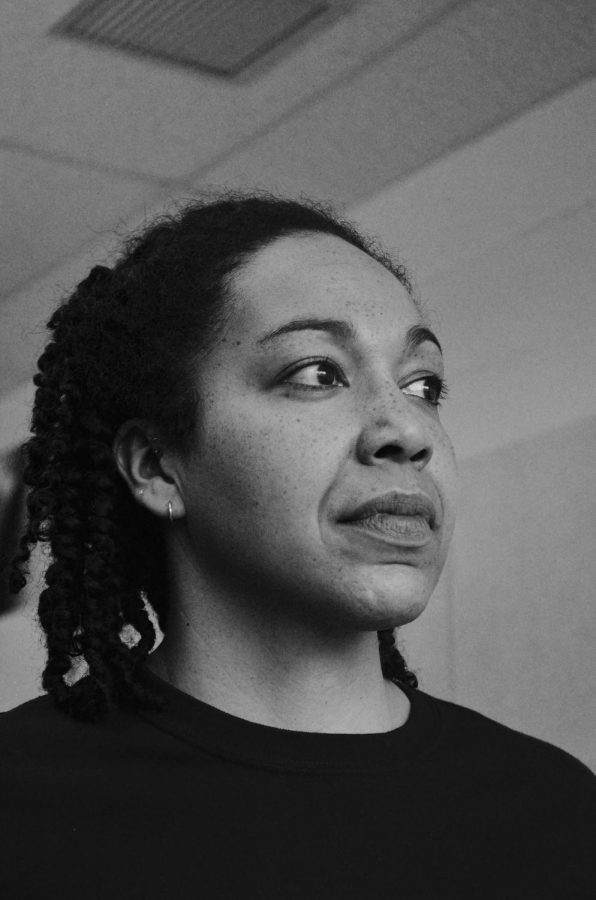Your donation will support the student journalists of West High School. Your contribution will allow us to purchase Scholarship Yearbooks, newsroom equipment and cover our annual website hosting costs.
In the minority
Though student bodies across the district are growing more diverse, teachers are not following this trend. Students, teachers and administrators highlight why this lack of racial representation is significant and what is being done to combat the issue.
February 22, 2019
Teachers. Coaches. Lunchroom staff. Paraeducators. Janitors.
These individuals are integral to shaping student futures and partake in a process that impacts society. While in these positions, each acts as a role model for many generations to come.
As students nationwide obtain their educations, movements have surged across the country. From the Congressional floor to Hollywood screens, encouraging diversity has become a vital part of the 21st century. But in an era in which minority representation has been advocated for in numerous career fields, it begs the question: is proportionate diversity found amongst everyday role models?
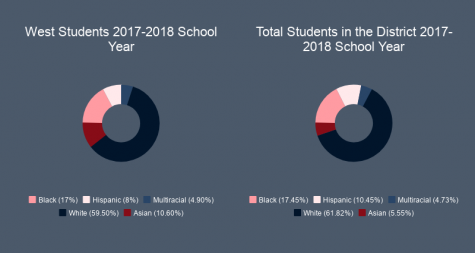
According to the 2015 National Center for Education Statistics, the answer is no. Around 51 percent of students nationwide identified as “non-white” in contrast to only 20 percent of teachers. The ICCSD mirrors this trend, as there are only 82 certified teachers that identify as people of color out of 1,141 total in the district. At some elementary schools, such as Borlaug Elementary, there are no certified teachers of color at all.
Jeremy Tabor, the ICCSD Director of Equity and Employee Relations, believes that minority students can better connect with teachers that look like them, which makes the lack of minority instructors concerning.
“In terms of overall effectiveness, it’s really about having that same life experience to be able to connect with students so that [adults] can empathize with what students are going through,” Tabor said.
The University of Iowa Public Policy Center’s “Student Experiences of School Climate in the ICCSD 2017” survey examined equity within the ICCSD. Key findings in this climate survey included statements like “Black students consistently report the lowest levels of equitable and respectful treatment by teachers” and “Asian students are the least likely to report that class materials and content represent them.”
“I think diversity is important for everyone,” said Chace Ramey, ICCSD Chief Human Resources Officer. “It enriches our education when our schools reflect our broader community. If we’re not taking steps to do that, we’re not providing our students the educational experience that they need and deserve.”
One area that has been scrutinized by the district in an effort to resolve these issues is the hiring process. While the goal is to increase diversity of new staff, Principal Gregg Shoultz has found that there aren’t many minority candidates available.
“Even though for Iowa we’re a diverse town, the pool of people going to college and then becoming teachers is not very diverse,” Shoultz said. “There have been several times where I haven’t had any [minority] candidates.”
West High remains one of many schools in the district that lacks a proportionate amount of minority teachers, with nine percent of teachers being persons of color compared to approximately 40 percent of students. Addressing this discrepancy, individuals share their thoughts on how the district’s lack of minority teachers impacts student experiences.
Some believe that through having more representation, students obtain a better perspective on diversity in the world around them.
“It’s a very globalized world and if you don’t have an understanding for other people, for other nations, other cultures, ethnicities, languages, races, it’s very hard to make it,” said Diego Rivera ’19, a Mexican-American student. “You don’t have an understanding of other people, or at very least, lack the empathy to really just put yourself in other people’s shoes.”
Voices from within
An identity crisis
When English teacher Nate Frese walks into a faculty meeting, he blends into the predominately Caucasian crowd. With a lighter complexion, it is no surprise that he is mistaken as white by students and teachers alike. Many don’t realize, however, that he is one of only seven minority certified teachers at West High.
Identifying as Mexican-American, Frese often questions if discussing his heritage is relevant in a classroom setting.
“I wrestle with this,” Frese said. “It’s not like I’m hiding anything about who I am. … It’s something that I’m proud of and I’m aware of and I own, but at the same time, I’m not trumpeting it.”
Minority teachers may face this internal dilemma, especially if they do not teach a subject involving frequent student discussion.
“I have a lot of pride in being Asian-American, but I don’t think I get to express that very much as a math teacher,” said Tiffany Chou. “This is something I could work on … to build better relationships. I have had students light up when they hear a little bit about my ethnic background.”
Originally from Southern California, Chou grew up in one of the largest Asian populations in the country. However, this was not mirrored in terms of her teachers, as she cannot recall having “very many” Asian teachers or Asian students in her classes while studying to become a teacher.
Similarly, Frese does not recall having any Hispanic teachers. Because of this, he believes having a teacher he could identify with on an ethnic level would have made school a more enjoyable environment.
“When [I was] younger and trying to formulate my identity, boy wouldn’t it have been a bit more comforting to see a few more Latino males on my teaching staff,” Frese said. “Maybe I never would’ve gone and talked to them, but just to know that they were there, I think, would’ve put me in a better mindset about certain elements about school.”
Cultivating connections
Asian students often lie under the radar when it comes to racial inequity discussions. However, climate survey data revealed that Asian students are the least likely to report having an adult at their school that they trust and go to for advice.
“If I were to have an Indian teacher, it would be easier to talk about things like a [Bollywood] dance performance coming up the next weekend, or what I would be doing during my upcoming trip to India,” said Niyati Deshpande ’21. “The connection would be better, and there would just be more of an understanding.”
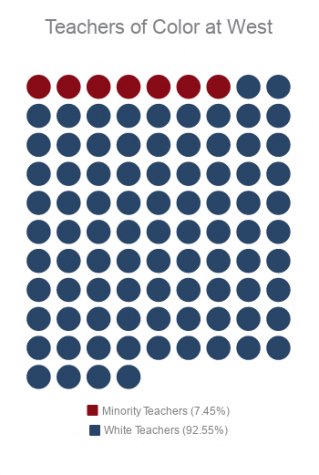
As a teacher, Frese also feels he can better connect with minority students. Throughout both his English teaching and basketball coaching careers, he has conversed with students who felt less alone due to having a minority mentor they can rely on.
“To know that there’s somebody else that went through something pretty similar and to see somebody like that, there’s a kind of calm and a release,” Frese said. “It’s like, ‘Okay, I’m not completely on an island here, and it will be okay. Here’s somebody that made it through that and [came] out the other side.’”
As one of the few African-American educators at West, science teacher Maureen Head has made personal connections with black students because of certain shared experiences that come with growing up black in America.
“I would never claim that there’s a monolithic black experience or monolithic biracial experience, but … there are certain shared experiences that we assume the other person has,” Head said. “Those shared experiences and those shared traumas [can] lead to a bigger sense of comfort when the students are talking to me.”
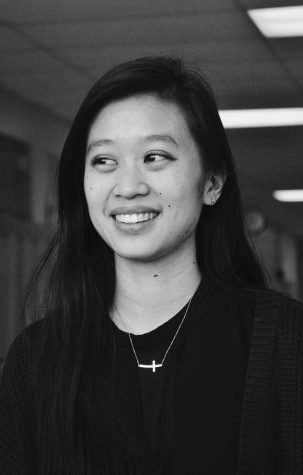
Tiffany Chou, a math teacher, identifies as Asian-American
African-American students like Ariana Moffett ’19 and Julian Jordan ’21 are just two of the many students who feel more comfortable coming to Head with their problems.
“She understands us,” Moffett said. “And she knows where we’re coming from because she in her life went through the same problems that we did. She can relate to us better than most other teachers could.”
“I felt like I’ve connected with other teachers on a personal level, but with her I feel like us both being biracial [created] a deeper connection,” Jordan said.
Head said that there are times when students come to her about racially insensitive comments made by teachers that the students don’t know how to respond to.
“I think sometimes the kid is venting and they just maybe need a place to process,” Head said. “Sometimes they’re looking [to tell someone], ‘Hey this was a really big deal, and something needs to be done about it. And what sort of steps do I take to make a difference?’”
Like Head, Northwest Junior High language arts teacher Amari Nasafi has taken personal experiences and translated them into interactions with African-American students and parents. For example, because he has a brother that was incarcerated multiple times, he’s connected with parents who had similar histories.
“I’ve had several African-American black students who have had situations that come up that I can connect with because we share that kind of background,” Nasafi said. “It’s not that I have any special knowledge, but sometimes when people find that out about me, it opens them up more. They don’t feel like I’m judging them, and that’s a huge hurdle.”
There are also some minority students who believe that while diversifying teaching staff is important, they have not personally felt disconnected from teachers based on race. Asian-American student Julie Shian ’20 believes that a teacher’s race is not as important to her as the effectiveness of their teaching.
“What’s most important is that a teacher makes an effort to try to help a student learn in a way that is best for them and makes their room approachable,” Shian said. “As long as teachers make efforts to make their students feel like they are in a comfortable learning environment, the connection is there.”
Suppressing stereotypes
When a student requires help in school, the first person they traditionally turn to is their instructor. However, for Robert Hooks ’20, this isn’t always the case. As an African-American student, he said he doesn’t want to perpetuate the stereotype regarding black students being “dumb,” so he prefers not to ask Caucasian teachers for assistance.
“I personally find it easier to seek help from a teacher who is African-American, because if I don’t understand something, I know I won’t be just another dumb black kid in their eyes,” Hooks said. “They truly want to see me succeed because they want me to be better than what society says I can be.”
Research done by Johns Hopkins University in 2017 concluded that if low-income black students have at least one black teacher in elementary school, they are significantly more likely to graduate and consider post-secondary education.
Another reason Nasafi can relate to black students is because he understands the stereotypes that they have to overcome and often faced similar ones growing up. According to Nasafi, the stereotype for African-American men is underperformance in school, so he felt that some teachers were taken aback by his interest in learning.
“It would creep into my mind sometimes whether I was performing really well or if they saw a young black boy who was interested in books, so they were encouraging me by being softer on me. I wanted to do well on my own merits, not because I was a representative of an underrepresented minority. I try to be like that as a teacher, too.”
The district climate survey showed that approximately 65 percent of black and multiracial students report that people at their school acted as if they were not smart. Jordan, who identifies as biracial, feels that this is true with teachers as well as students, as he believed teachers had lower standards for him because of his race.
“I feel like it can come out of good intentions, … like some teachers will go out of their way to help students because they feel like they’re not intelligent enough to get it,” Jordan said. “But I feel like there are some teachers who do have low expectations for minorities.”
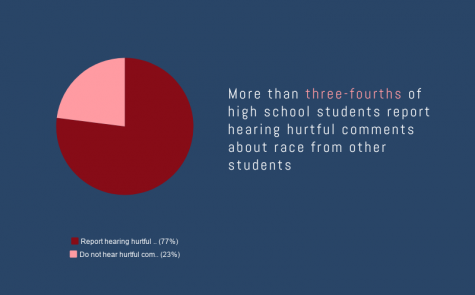
There are also students like Moffett who feel that negative stereotypes against African-American students perpetuated by students and teachers discourage students from seeking success.
“It’s kind of hard for someone when everyday you have to be strong and try to fight [stereotypes],” Moffett said. “After a while, everyone has a breaking point. So when you meet that breaking point, you want to fall into that stereotype, like, ‘Okay, I’m going to drop out. They expected me to do that anyway.’”
Moffett also cited several instances when teachers directly discriminated against African-American students based off of stereotypes of black students not being as well-behaved. There were multiple times when she or her friends were stopped in the hallways by teachers and questioned about where they were going, while non-black students did not receive the same treatment.
“Everyday I feel like I’m fighting a battle that I’m not going to win,” Moffett said, “because there are so many stereotypes against me.”
Because of instances like this, Moffett firmly believes that incorporating more minority teachers into the district would improve experiences for African-American students in particular.
“You [would] have more students opening up to teachers, telling them what their problems are and just feeling that there’s someone they can connect with, someone that’s on their side,” she said. “Everyone needs someone in their corner.”
Equity actions
Recruitment and retention
Addressing the lack of minority teachers in the ICCSD is a process that has yet to be completed. While the most obvious solution is to hire more teachers of color, this is easier said than done, as the district prioritizes hiring teaching staff that come out of Iowa colleges and universities. Because the people graduating from these institutions are primarily white, this is reflected in the teacher candidate pool.
Ramey intends to announce a plan to the ICCSD school board on March 12 regarding how he and his committee plan to increase teacher diversity. This proposal includes components regarding both recruitment and retention.
“It’s one thing to recruit and hire people to come to the school district, but if we can’t offer a rewarding experience inside the schools, people aren’t going to stay in the community,” Ramey said. “[We’re] looking at recruiting differently and in different places, and also … creating pathways for people that are already in the school district.”
One school that has experienced greater success attracting teachers of color is Kirkwood Elementary. They have the most diverse teaching staff in the ICCSD with 24 percent of their teachers being teachers of color. Principal Anita Gerling says this is largely due to word of mouth, reaching out to colleagues and networking.
“A diverse staff means many things,” Gerling said. “It means race, it means gender, it means how much experience you have. You want some new ideas, some new people just out of college, you want some people who have some experience in the classroom, [and] all of those pieces play a part in who I bring to the table to interview.”
Because it is difficult to attract certified teachers of color to the ICCSD, one initiative Nasafi would like to see developed is incorporating more adults of color into the building to mentor or work with students, whether that be paraeducators or other support staff.
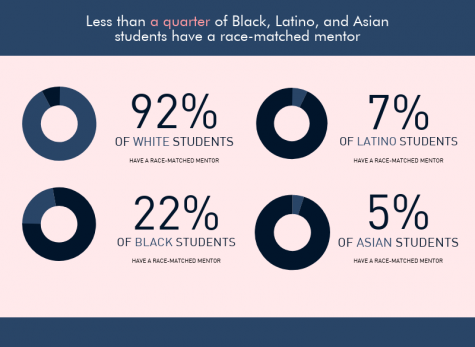
“We’ve got more and more of those people in the building, and a lot of them have been really helpful with the kids,” Nasafi said. “If you can’t get certified teachers because there’s a paucity of them, why not get as many other adults to interact in the community as you can?”
Gerling follows the mirrors and windows philosophy. This idea states that children should see individuals that look like them, as well as those who reflect the world around them.
“I think that not only does [having minority teachers] support our students of color, but it also supports our Caucasian students as well, because that’s a window for them,” Gerling said.
According to Nasafi, the mirrors and windows philosophy can also be applied to reading materials. One of his goals when teaching fiction texts is to utilize works that represent the lives of people students can identify with.
“There’s been a big push in language arts to make classrooms as culturally inclusive as possible,” Nasafi said. “Kids are just more likely to get engaged when they’re reading stories that connect with them.”
Improving the existing environment
Due to the current hiring freeze on teachers as a result of budget cuts (see story on pages 8-9), the district temporarily cannot employ more teachers, so Ramey’s plans will be put on hold. In lieu of hiring additional minority teachers, the ICCSD has focused on equity initiatives aiming to improve teacher awareness and student interactions.
Tabor believes that training existing staff to be more approachable to minority students is perhaps more plausible than focusing on finding minority teachers.
“We’re not going to all of a sudden create this flow of minority teachers that will come in,” Tabor said. “That’s not saying that our current teachers are ineffective, but we just have to continue to expand everyone’s skills across the district to make sure that we’re doing the best thatwe can to support our students.”
This mentality has been implemented through implicit bias training for all teachers across the district. Circe Stumbo, founder and president of West Wind Education Policy, is the designer of a three-year training process that worked with the district to train teachers to guard against implicit biases.
“The intention is to better understand why we have racial disproportionality in student experiences and student outcomes,” Stumbo said. “One of the hypotheses is that implicit racial bias might be playing a role in underlying the disproportionality we see.”
The teachers undergo 10 hours of professional development training over several months. During this, they talk about race, discuss implicit bias as a cognitive function and work to develop their understandings of personal biases.
“This is a program that’s designed to help us understand the bigger stories and history around race in the United States and how that impacts us today,” Stumbo said. “It really is the work of saying, ‘What do we encounter every day as we live here in the United States, and how does that affect us in ways that we don’t realize?’”
However, students like Moffett are doubtful that items like implicit bias training will produce tangible change. In her opinion, racism is an issue that won’t be solved solely by a required course.
“It’s going to take time and patience,” she said. “And you have to want to change, whereas some of these teachers, I don’t feel like they want to change.”
Diversification is an ongoing process that, while lacking a clear solution, is becoming more of a priority. Frese believes it is important to note the difference between tolerance and acceptance as the district continues to strive towards equity for students of all races.
“You hear the word tolerance all the time, but it’s not about tolerance. You tolerate a cold. You tolerate things that are an annoyance to you. We should not be working towards tolerance,” Frese said. “We should be working towards understanding, acceptance, empathy. True inclusion is you don’t even recognize the word inclusion because everybody’s part of it.”

